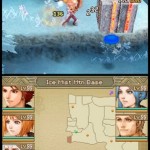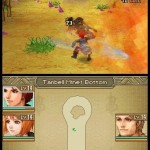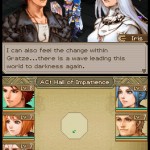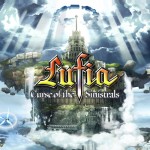LUFIA: CURSE OF THE SINISTRALS
 Also Known As: Estpolis: The Lands Cursed by the Gods (エストポリス)
Also Known As: Estpolis: The Lands Cursed by the Gods (エストポリス)
Genre: Action Role-Playing Game
Platform(s): Nintendo DS
Allegiance: Neverland, published by Square-Enix (JP), NATSUME (NA)
Vintage: 2010
Rating: E10+
Intelligence Agency Report by: Dr. Magnanimus
The peace of the world abruptly came to an end when a god of immense destructive power descended from the heavens to herald the arrival of the Sinistrals, four dark gods that have declared war on humanity. Revealing himself as Gades, the Sinistral of Destruction, the deity threatened ruin and devastation on all who opposed the Sinistrals’ rule. A monster-hunter named Maxim, always eager for challenge and adventure, decided to venture forth to the Soma Temple where Gades resided and become the first man to test his mettle against the evil god. With the world’s bravest warriors at his side, the young adventurer soon takes it upon himself to stop the Sinistrals’ evil schemes and restore order to the threatened world.
| Plot Gameplay Impact Visual Audio |
9.75 9.50 9.75 9.00 9.75 |
|
| Overall | 9.75 |
Field Agent Report by Dr. Magnanimus
The Nintendo DS is arguably one of the best modern handheld consoles for accommodating role-playing games. This can certainly be said for Neverland’s remake of the classic Lufia series, which has made good use of the system’s capabilities and then some. The player controls Maxim and his friends in a fully three-dimensional world, with towns, dungeons and other locales accessible from an overworld map selection-screen from the party’s globetrotting ship. Although the game maintains the primary elements of role-playing through leveling, treasure-hunting, and collecting gold and items from defeated monsters and the like, a lot of the gameplay is more dependent on action. The player can jump, dodge, attack with weapons, and activate special skills and magic to progress through the game, using simple button presses, directional controls, and the occasional use of the stylus. Players can easily switch control between Maxim and the other party members to make use of their individual strengths and abilities in order to overcome various obstacles, puzzles, and monster fights. Combat is very fluid and integrated with the 3D environment, and it does not rely on a complex battle-command system or turn-based system as did the previous titles. This makes the game very easy for new players to pick up, even if they have never played a role-playing game before. In addition to leveling up, characters can obtain more power through the Mystic Stone Board, or GRID system. Placing stones collected throughout the adventure on the board activates additional bonuses for each character and boosts their stats at a greater rate than leveling could normally. The board is a way to help all players to enhance a character’s fighting ability, particularly when pure action-control skill may not be enough to win a particularly difficult battle.
Although many bells and whistles abound, quite a few past elements have been well-preserved in this remake. The Lufia series’ core puzzle component makes a glorious return in the DS remake, with even more exciting, stimulating challenges to test the heroes’ minds just as much as their mettle. Furthermore, the Ancient Cave has been brought back once again to challenge hardcore endgamers to a frenzied 100-floor gauntlet of monsters and treasure where only the most skilled adventurers will manage to reach the bottom and find the rarest rewards. This combination of old and new is sure to appeal to many veterans of the series and give newcomers a sense of the fun, unique experiences Lufia can offer over other well-known titles.
Many of the visuals in the game were completely revamped in comparison with the earlier incarnations of the Lufia universe. The world is more distinctly technologically-advanced, yet still on the very cusp of industrial-era modernity. The towns and kingdoms are lively and filled with interesting sights and architectural designs that are distinct to each region. The NPCs and townsfolk take on a life of their own, more so than in some of the earlier Lufia games, with memorable personalities and conversations with the heroes. It could be argued that the monster designs are a bit generic and under-developed (made worse by the resolution limitations of the DS screens), but the Sinistrals themselves are much more interesting to look at, and they command the intimidating presence that they are meant to convey as celestial invaders.
Yasunori Shiono reprises his role as composer for the Lufia series to direct the music for the remake. His decision to reuse the original soundtracks from Lufia & The Fortress of Doom and Lufia II: The Rise of the Sinistrals was a good move that has certainly pleased many long-time fans of the series. The revamped versions, while having been repurposed theme-wise, nonetheless remain unchanged in their atmospheric impressions on the player. The original music was considered to be some of the most memorable among JRPGs, and it continues to move players even in this remake.
One of the most remarkable parts of the Lufia series is its devotion to a compelling storyline and characters. It is easy to dismiss the premise as a generic fantasy adventure about heroes saving the world from destruction. However, in much of the dialogue between battles and questing, there is a very human element at work. Maxim, once content with being a fiercely independent swordsman with a lust for adventure and an outlet to test his incredible strength and mysterious power, eventually starts to bond with his comrades in such a way that his objectives mature into interdependence. As a leader, he serves his purpose as the spearhead in whatever mission his party may be on—but many of the other characters lend their unique talents and perspectives, as well. It is this strength of camaraderie and compassion that is ultimately put to the test when the party must face off against the cruel tyranny and hatred of the Sinistrals, who desire nothing short of ruin, chaos, and the utter subjugation of humanity. Ultimately, it demonstrates the power of the human spirit in face of adversity, regardless of where it may originate from.
Lufia: Curse of the Sinistrals accomplishes exactly what it set out to do. It reintroduces players to the Lufia series, and it does much to keep the original elements of the title that make it memorable and fun, while adding features to accommodate new players and create new possibilities for future titles. The three-dimensional world is colorful and highly engaging, and the controls are very efficient and easy to use. More importantly, however, the impact of the story and characters stay true to its roots, and it continues to provide a rich experience for gamers to enjoy and talk about for years to come. Many games come and go in the RPG market, so it’s refreshing to know that a series like Lufia will still be around, protecting the world of video games from monotony and mediocrity.









